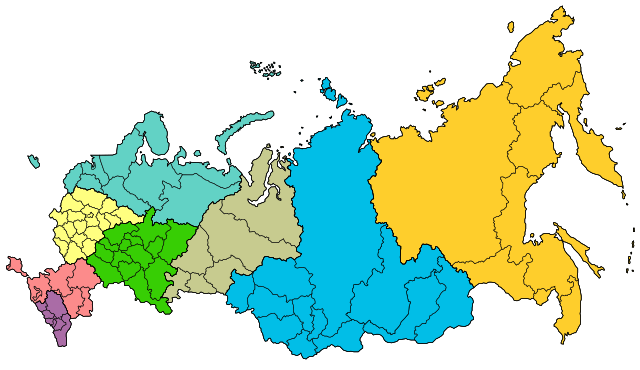European Russia
Western and most populated part of Russia From Wikipedia, the free encyclopedia
European Russia[a] is the western and most populated part of the Russian Federation. It is geographically situated in Europe, as opposed to the country's sparsely populated and vastly larger eastern part, Siberia, which is situated in Asia, encompassing the entire northern region of the continent. The two parts of Russia are divided by the Ural Mountains and Ural river, bisecting the Eurasian supercontinent. European Russia covers the vast majority of Eastern Europe, and spans roughly 40% of Europe's total landmass, with over 15% of its total population, making Russia the largest and most populous country in Europe. The region is divided into five Federal districts.
You can help expand this article with text translated from the corresponding article in Russian. (January 2025) Click [show] for important translation instructions.
|
European Russia | |
|---|---|
| Largest city | Moscow |
| Demonym(s) | Russian |
| Area | |
• Total | 5,549,100 km2 (2,142,500 sq mi) (7th) |
| Population | |
• 2023 estimate | 109,455,000[1] (13th) |
• Density | 27.5/km2 (71.2/sq mi) (160th) |
| GDP (PPP) | 2022 estimate |
• Total | $3.275 trillion[2] |
• Per capita | $29,923 |
| GDP (nominal) | 2022[3] estimate |
• Total | $1.410 trillion |
• Per capita | $12,926 |
Area and demographics
European Russia accounts for about 80% of Russia's total population. It covers an area of over 3,969,100 square kilometres (1,532,500 sq mi), with a population of nearly 110 million—making Russia the largest and most populous country in Europe, surpassing second-place Germany.[4][b] European Russia is the most densely populated region of Russia, with a population density of 27.5 people per km2 (70 per sq mi).[5] European Russia counts for about 15% of Europe's total population.
All three federal cities of Russia lie within European Russia. These cities are Moscow, the nation's capital and largest city, which is the most populous city entirely within Europe; Saint Petersburg, the cultural capital and the second-most populous city in the country; and Sevastopol, located in Crimea, which is internationally recognized as part of Ukraine.
Of the 16 Russian cities with over 1 million inhabitants, 12 lie within European Russia: Moscow, Saint Petersburg, Kazan, Nizhny Novgorod, Samara, Ufa, Chelyabinsk, Rostov-on-Don, Krasnodar, Voronezh, Perm and Volgograd (the remaining four are Yekaterinburg, Omsk, Krasnoyarsk and Novosibirsk).
History
Summarize
Perspective

The historical population of European Russia was composed of Slavic, Finno-Ugric, Germanic, Turkic, Jewish, Scythian, North Caucasian, Hunnic and Baltic peoples.[6][7]
Some theories say that some early Eastern Slavs arrived in modern-day western Russia (also in Ukraine and Belarus) sometime during the middle of the first millennium AD.[8] The Eastern Slavic tribe of the Vyatichis was native to the land around the Oka river. Finno-Ugric, Baltic and Turkic tribes were also present in the area (although large parts of the Turkic and Finno-Ugric people were absorbed by the Slavs, there are great minorities in European Russia today). The western region of Central Russia was inhabited by the Eastern Slavic tribe of the Severians.
One of the first Rus' regions according to the Sofia First Chronicle was Veliky Novgorod in 859. In late 8th and early-to-mid-9th centuries AD the Rus' Khaganate was formed in modern western Russia. The region was a place of operations for Varangians, eastern Scandinavian adventurers, merchants, and pirates. From the late 9th to the mid-13th century a large section of today's European Russia was part of Kievan Rus'. The lands of Rus' Khaganate and Kievan Rus' were important trade routes and connected Scandinavia, Byzantine Empire, Rus' people and Volga Bulgaria with Khazaria and Persia. According to old Scandinavian sources among the 12 biggest cities of Kievan Rus' or Ancient Rus' were Novgorod, Kiev, Polotsk, Smolensk, Murom and Rostov.[9]

Through trade and cultural contact with Byzantine Empire, the Slavic culture of the Rus' adopted gradually the Eastern Orthodox religion. Many sources say that Ryazan, Kolomna, Moscow, Vladimir and Kiev were destroyed by the Mongol Empire. After the Mongol invasion the Muscovite Rus' arose, over all this time, western Russia and the various Rus' regions had strong cultural contacts with the Byzantine Empire, while the Slavic culture was cultivated all the time.[10] The elements of East Slavic paganism and Christianity overlapped each other and sometimes produced even double faith in Muscovite Rus'.[11]
Economy
In 2022 the GRDP of European Russia was around ₽100 trillion (US$1.4 trillion).[3]
Alignment with administrative divisions
Summarize
Perspective

The following Federal districts of Russia are wholly or partly European:
| Name of district | Area (km2) |
Population (2023) |
Population density | GRDP (2022) | Continent notes | |
|---|---|---|---|---|---|---|
| Central Federal District | 650,200 | 40,198,659[1] | 59.658 | ₽47.368 trillion ($692 billion)[3] |
Europe | |
| North Caucasian Federal District | 170,400 | 10,251,083[1] | 56.58 | ₽3.111 trillion ($45 billion)[3] |
Europe | |
| Northwestern Federal District | 1,687,000 | 13,840,352[1] | 8.25 | ₽18.929 trillion ($276 billion)[3] |
Europe | |
| Southern Federal District[note 1] | 447,900 | 16,624,081[1] | 33.46 | ₽9.816 trillion ($143 billion)[3] |
Europe | |
| Volga Federal District | 1,037,000 | 28,540,832[1] | 28.63 | ₽19.664 trillion ($287 billion)[3] |
Predominantly Europe | |
| Ural Federal District | 1,818,500 | 12,262,205[1] | 6.86 | ₽20.073 trillion ($293 billion)[3] |
Predominantly Asia - Europe | |
| Sum of 6 Federal Districts[note 2] | 3,995,200 | 109,455,000[1] | 27.22 | ₽98.890 trillion ($1444 billion)[3] |
Predominantly Europe | |
| ||||||
See also
Notes
- Russian: Европейская Россия, also Европейская часть России "European part of Russia" or Европейская территория России "European territory of Russia".
- Turkey is only partially in Europe, in East Thrace, which has a population of about 12 million.
References
Wikiwand - on
Seamless Wikipedia browsing. On steroids.



